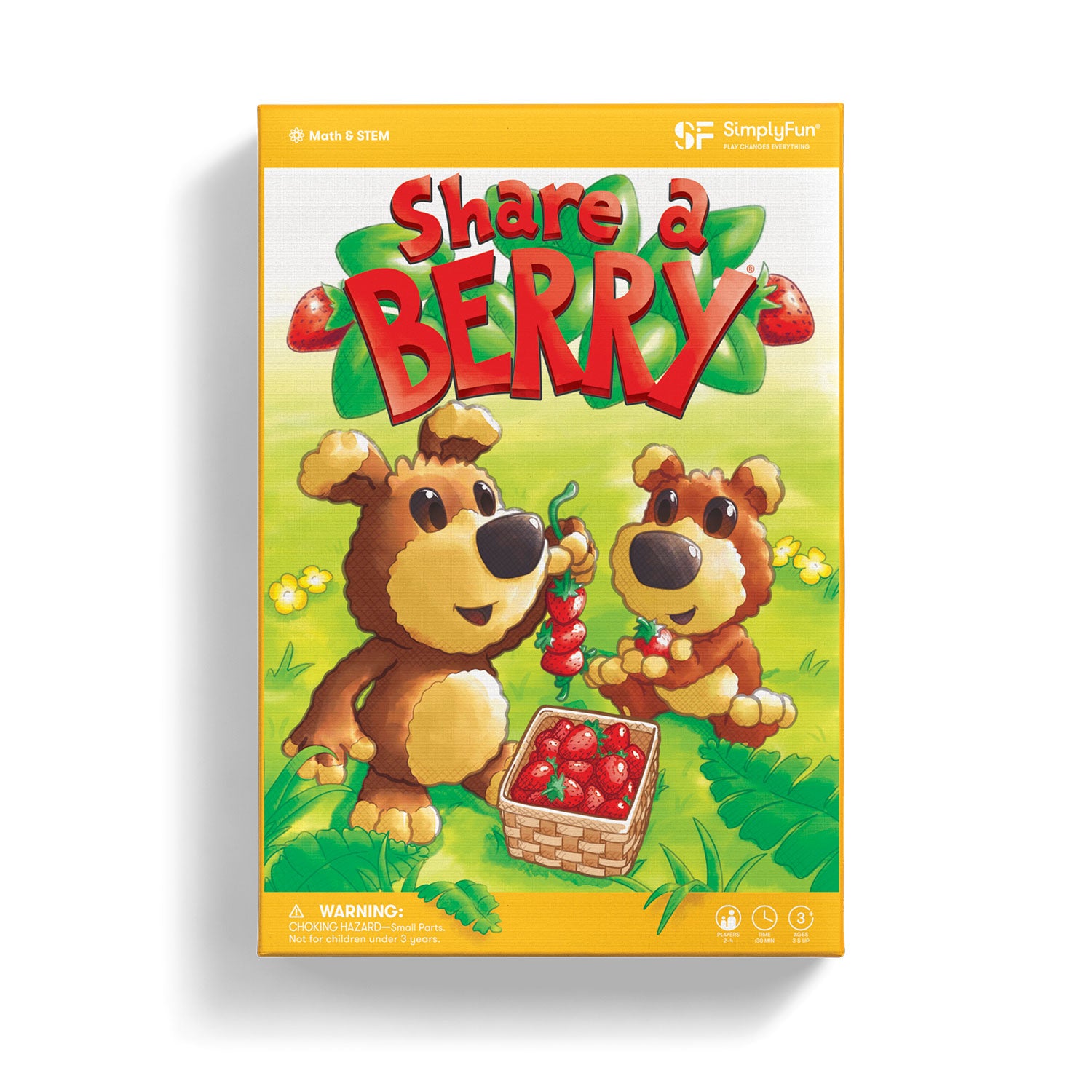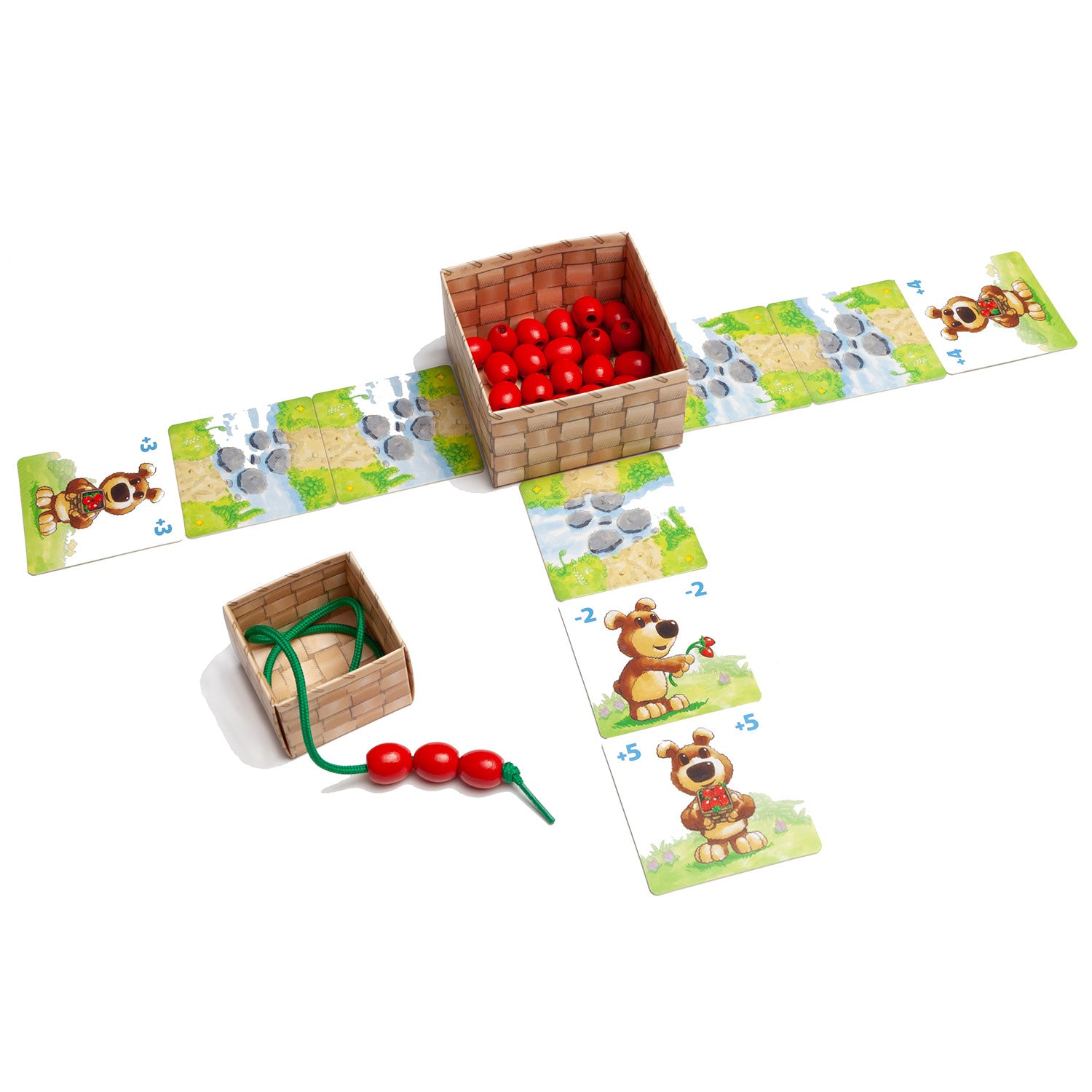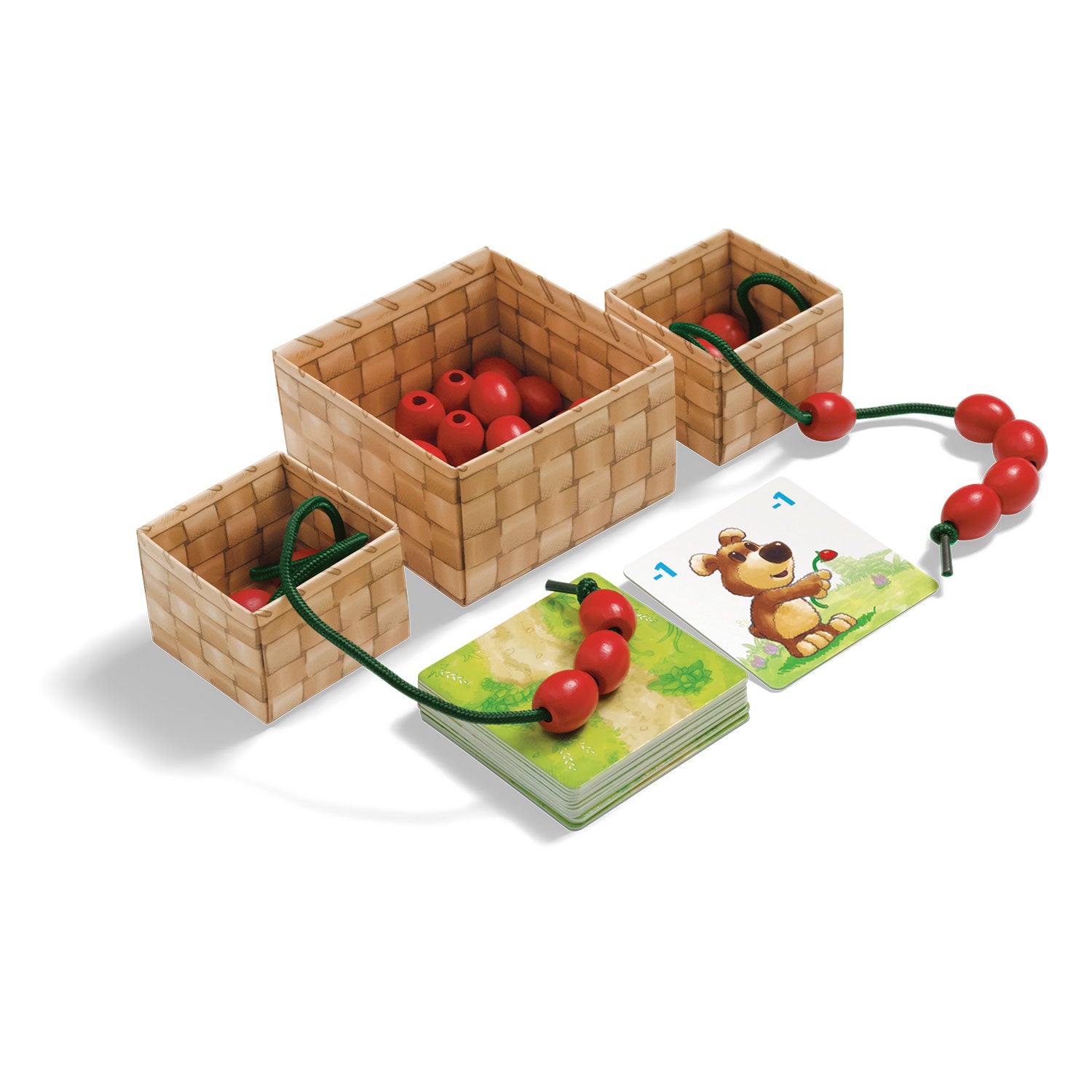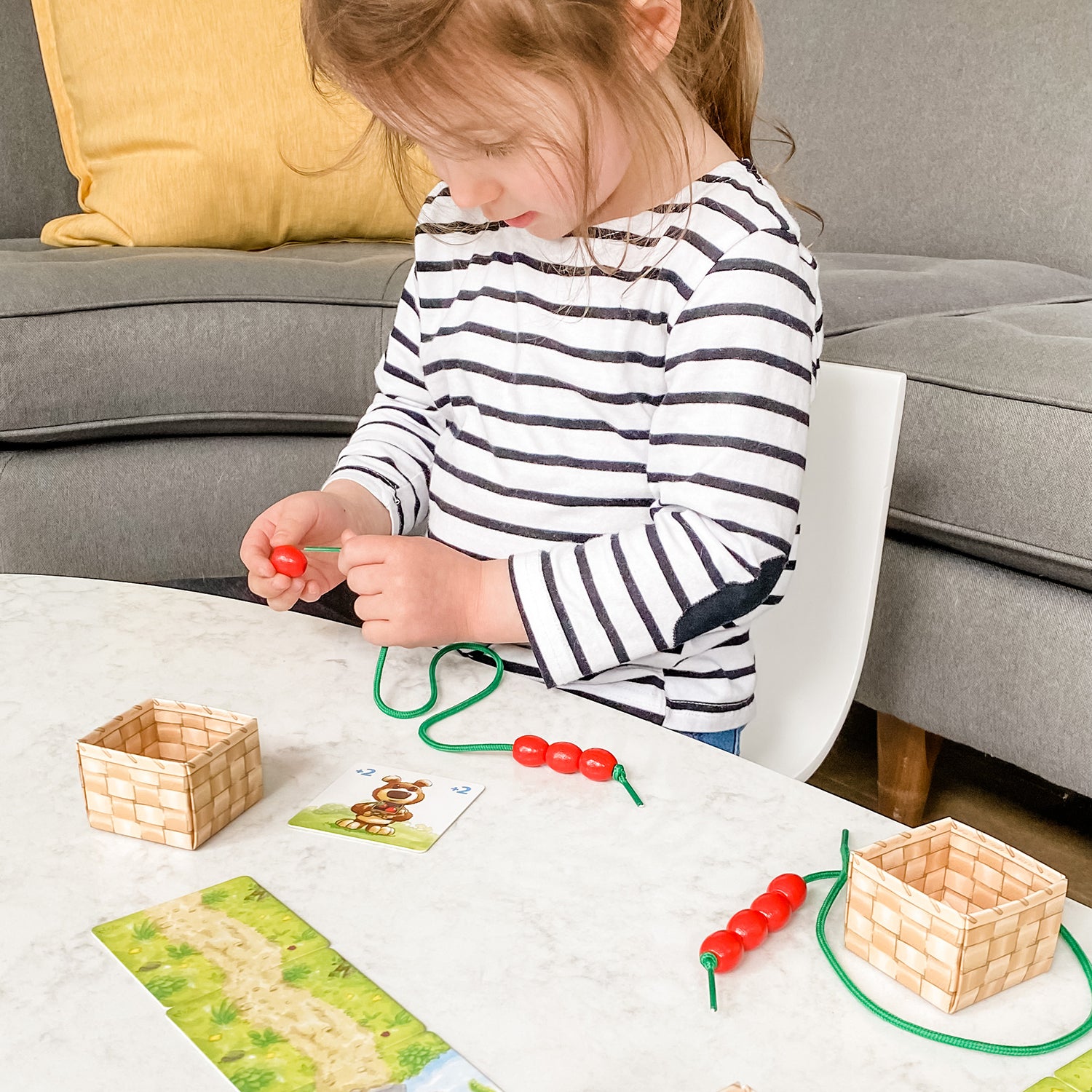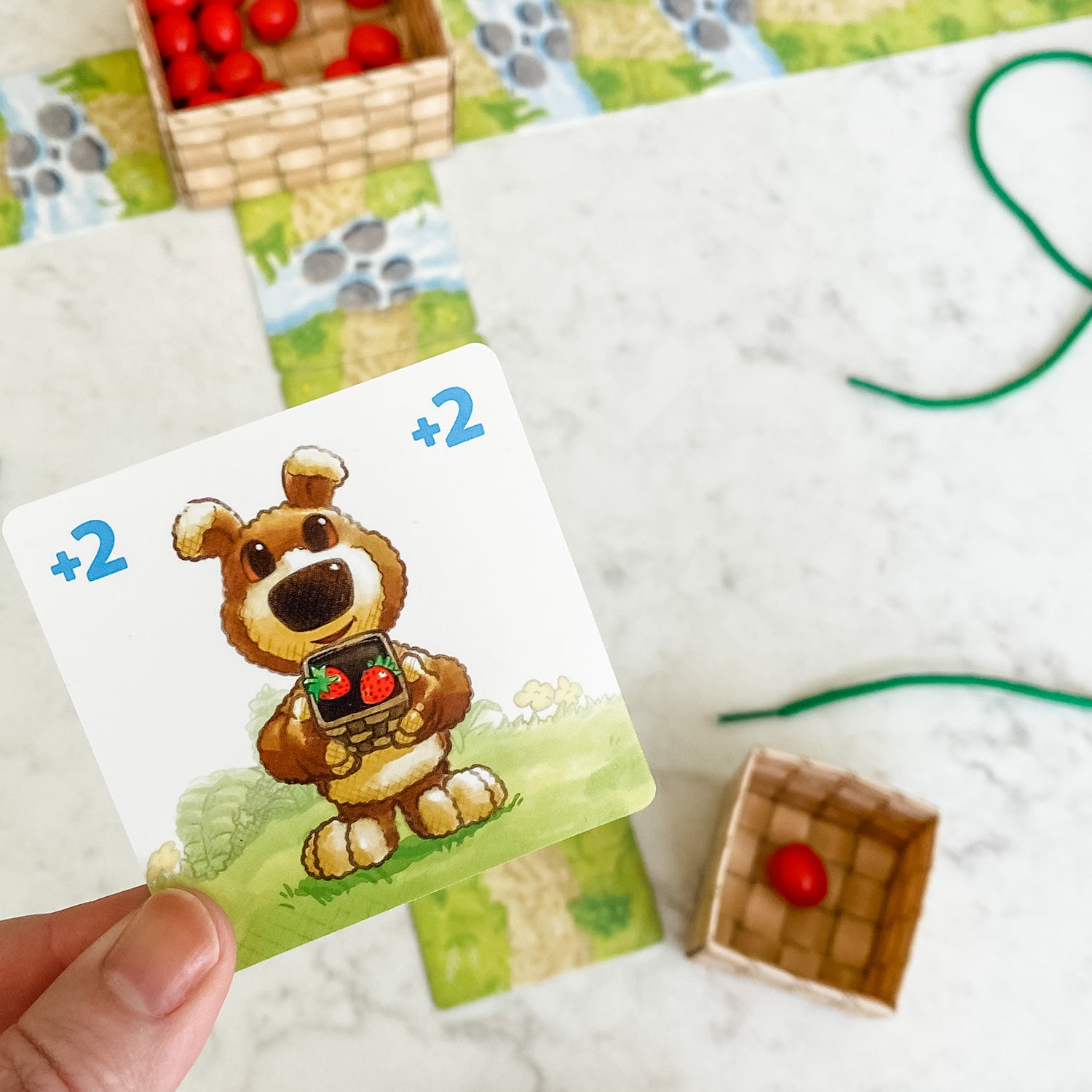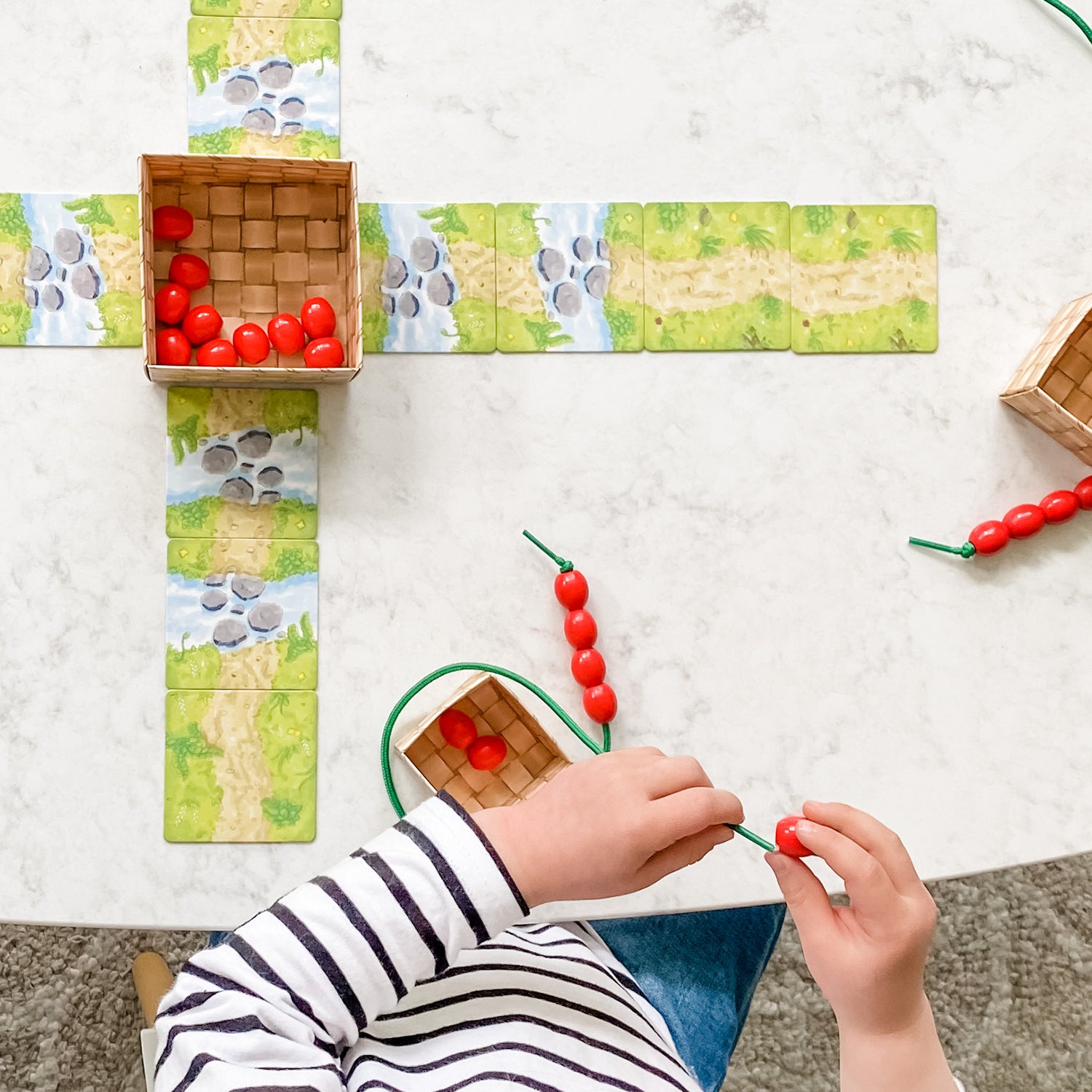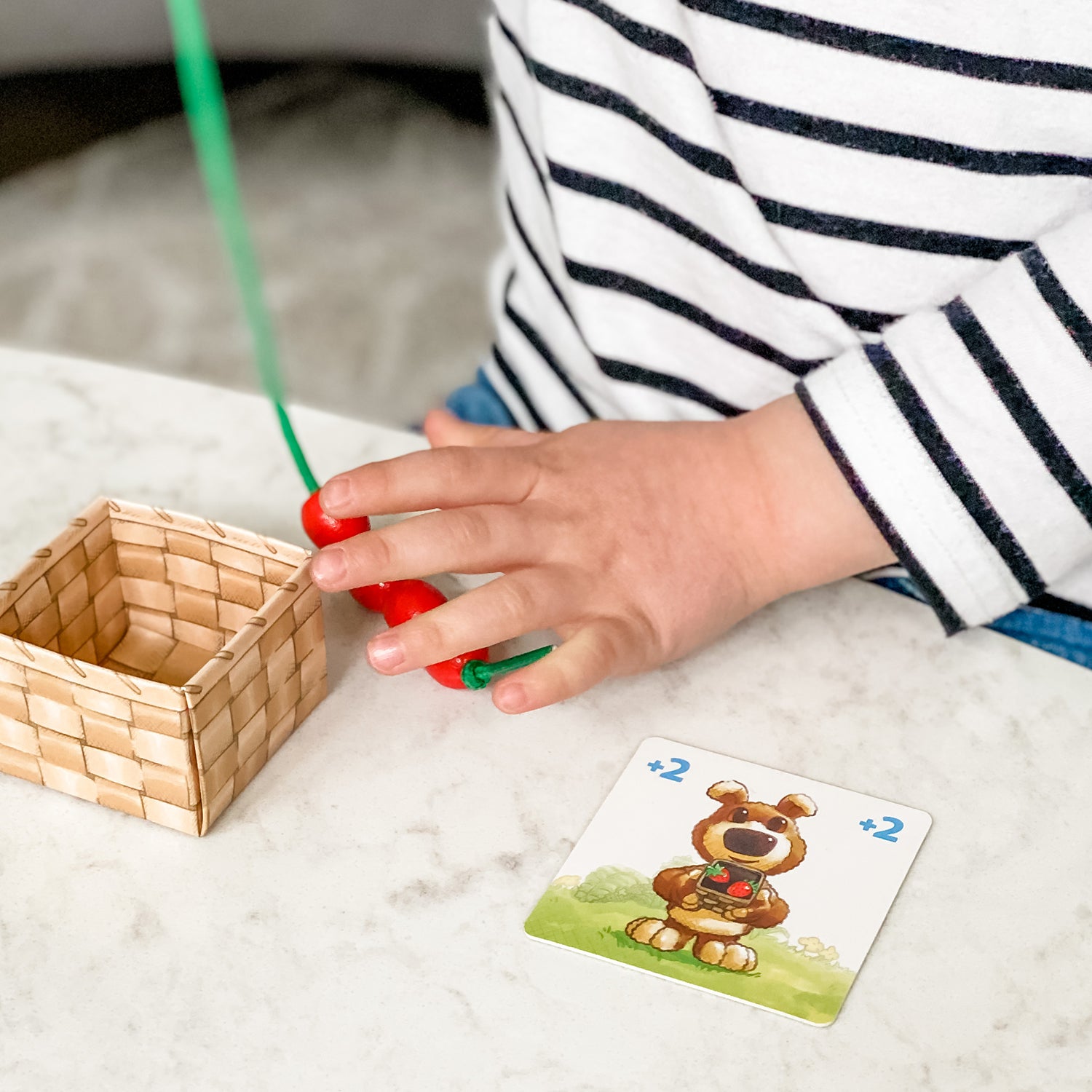Share a Berry
Share a Berry
2-4 players • 30 min • 3 & up
Focus: Counting
Couldn't load pickup availability
Turn your cards over and add berries to your string, then follow Beary’s directions to either share or receive a berry from another player. Collect the most berries to win. A fun way for young players to develop fine motor skills and learn to take turns.
Skills: Counting, Fine Motor Skills
Game Includes
Game Includes
- 28 Wooden Strawberries
- 16 Berry Path Tiles
- 8 River Path Tiles
- 4 Strawberry Strings
- 4 Mini Berry Baskets
- 1 Big Berry Basket
- 1 Rules Booklet
Share
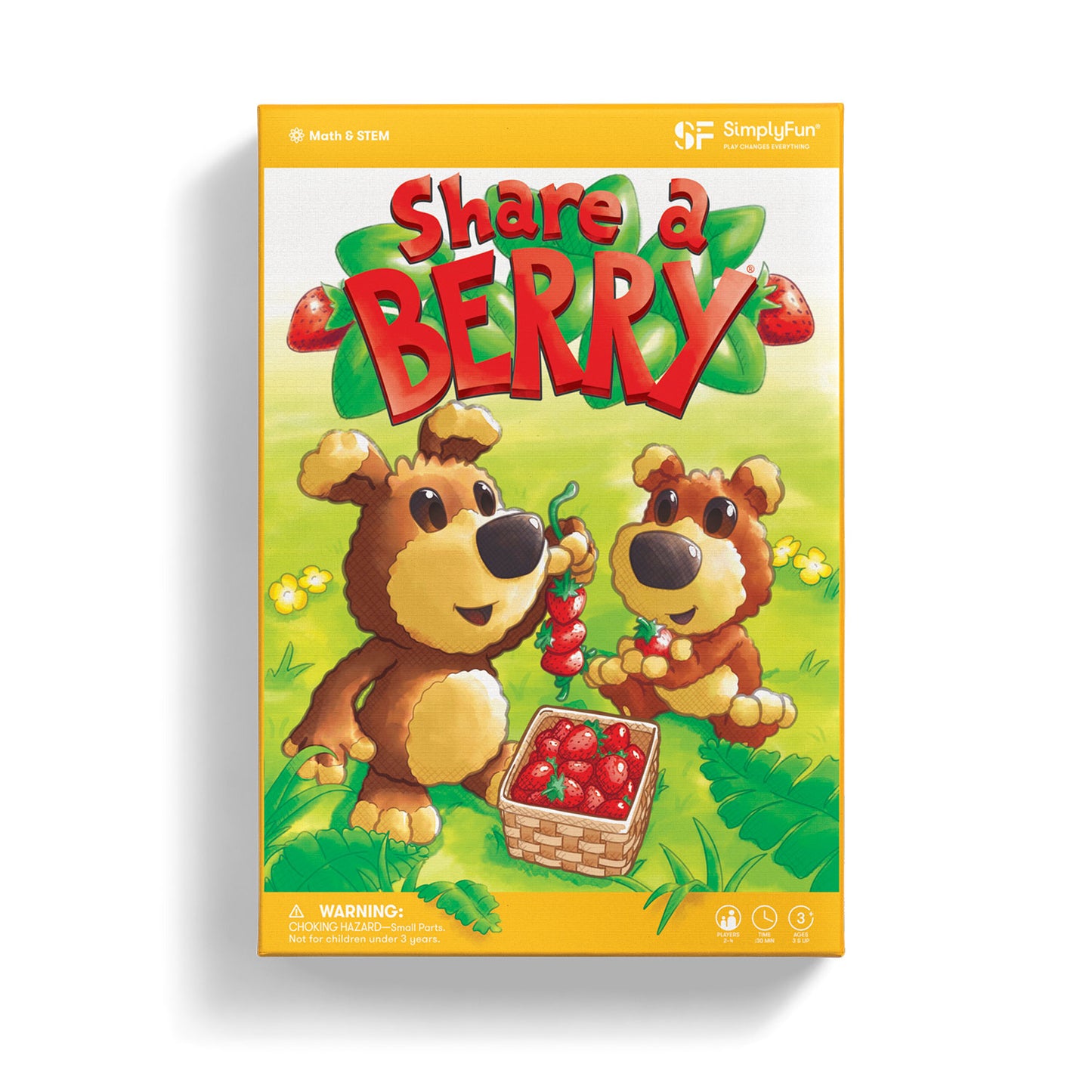
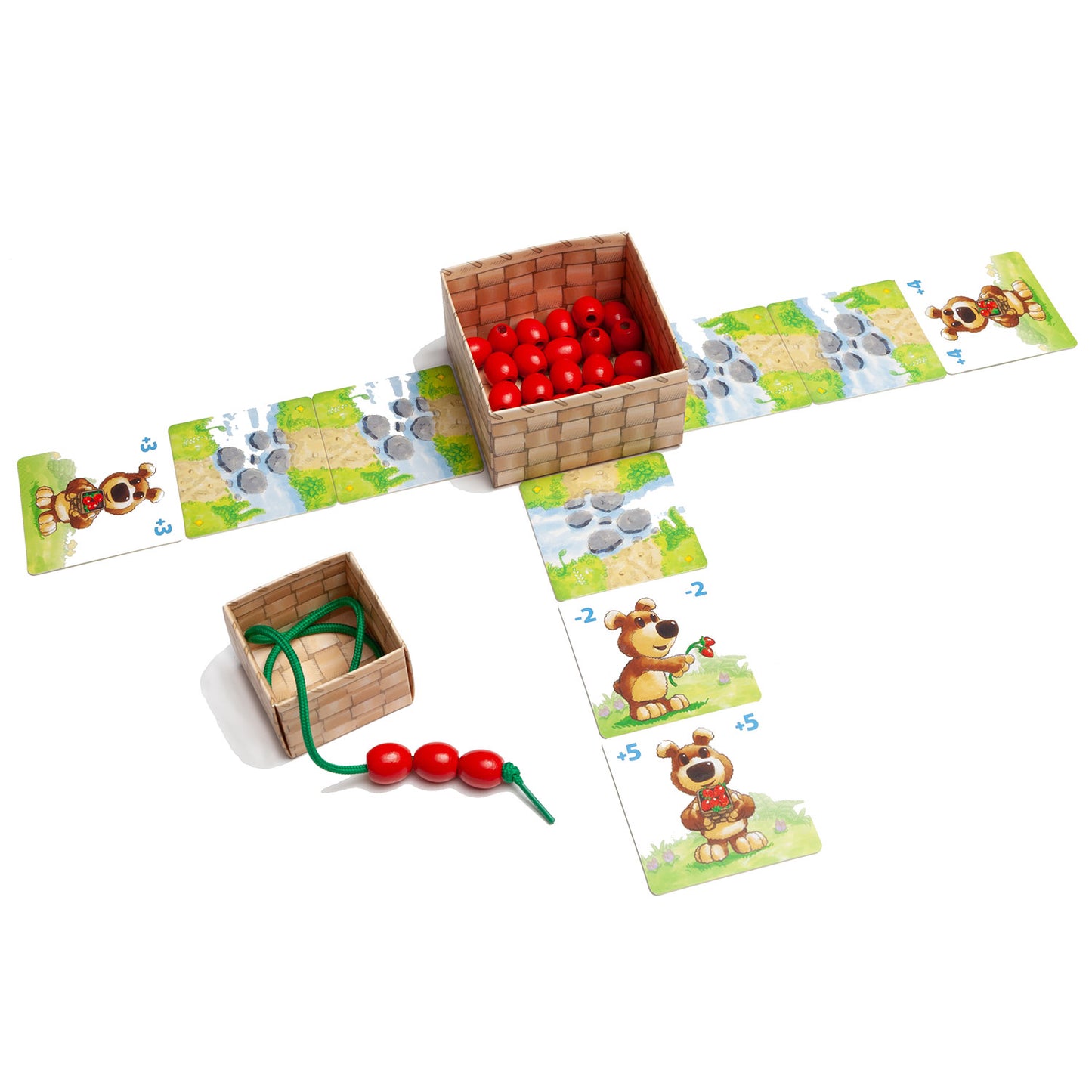
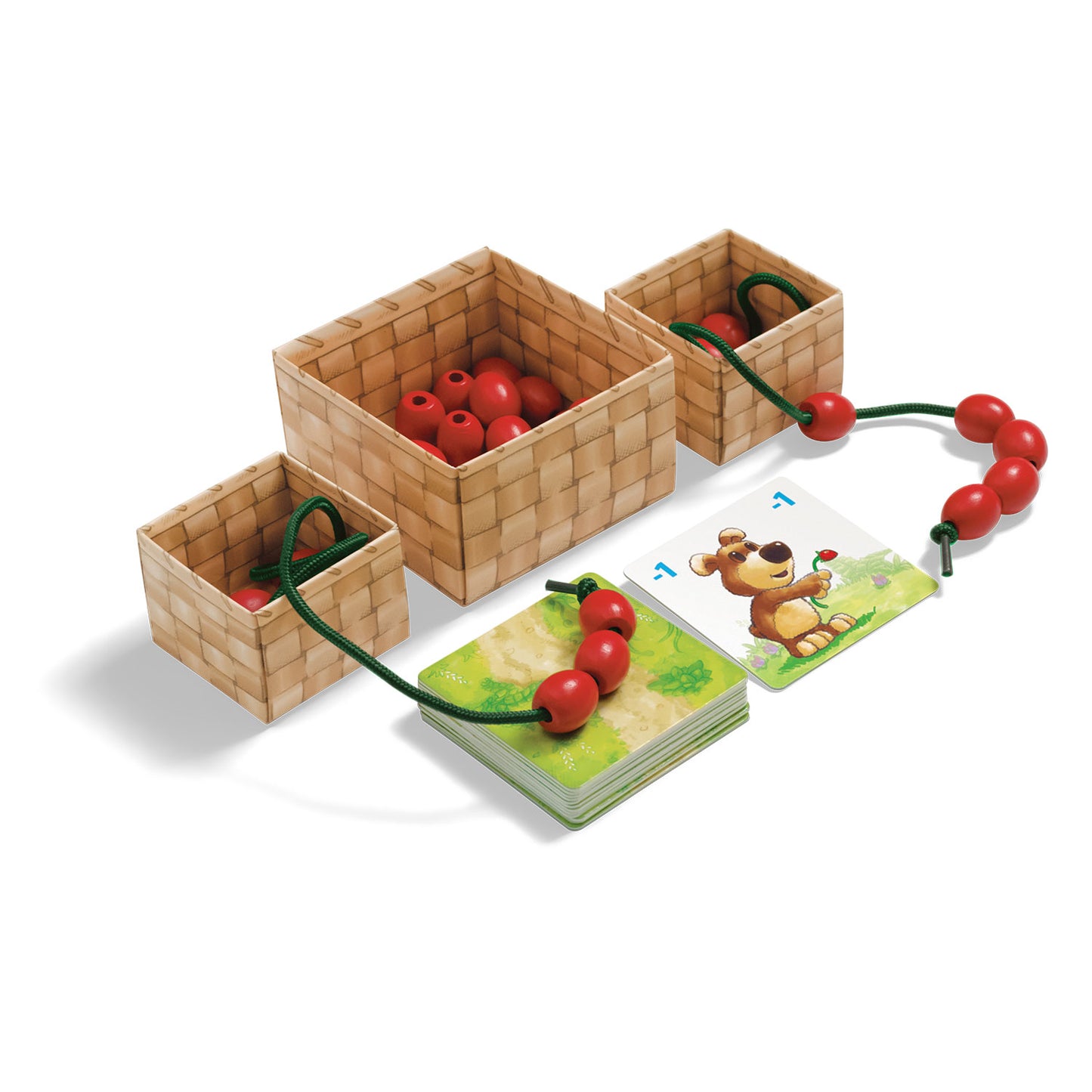
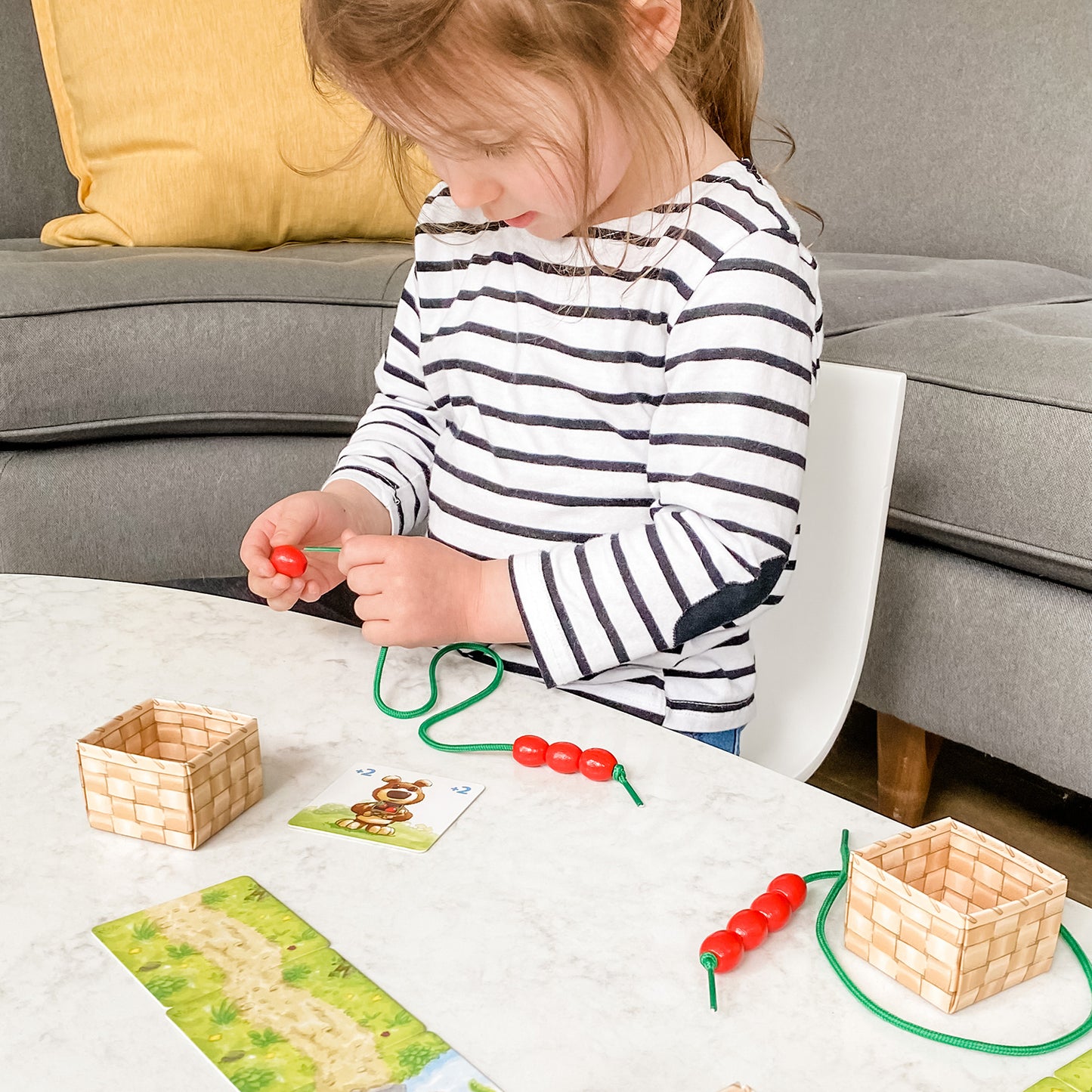
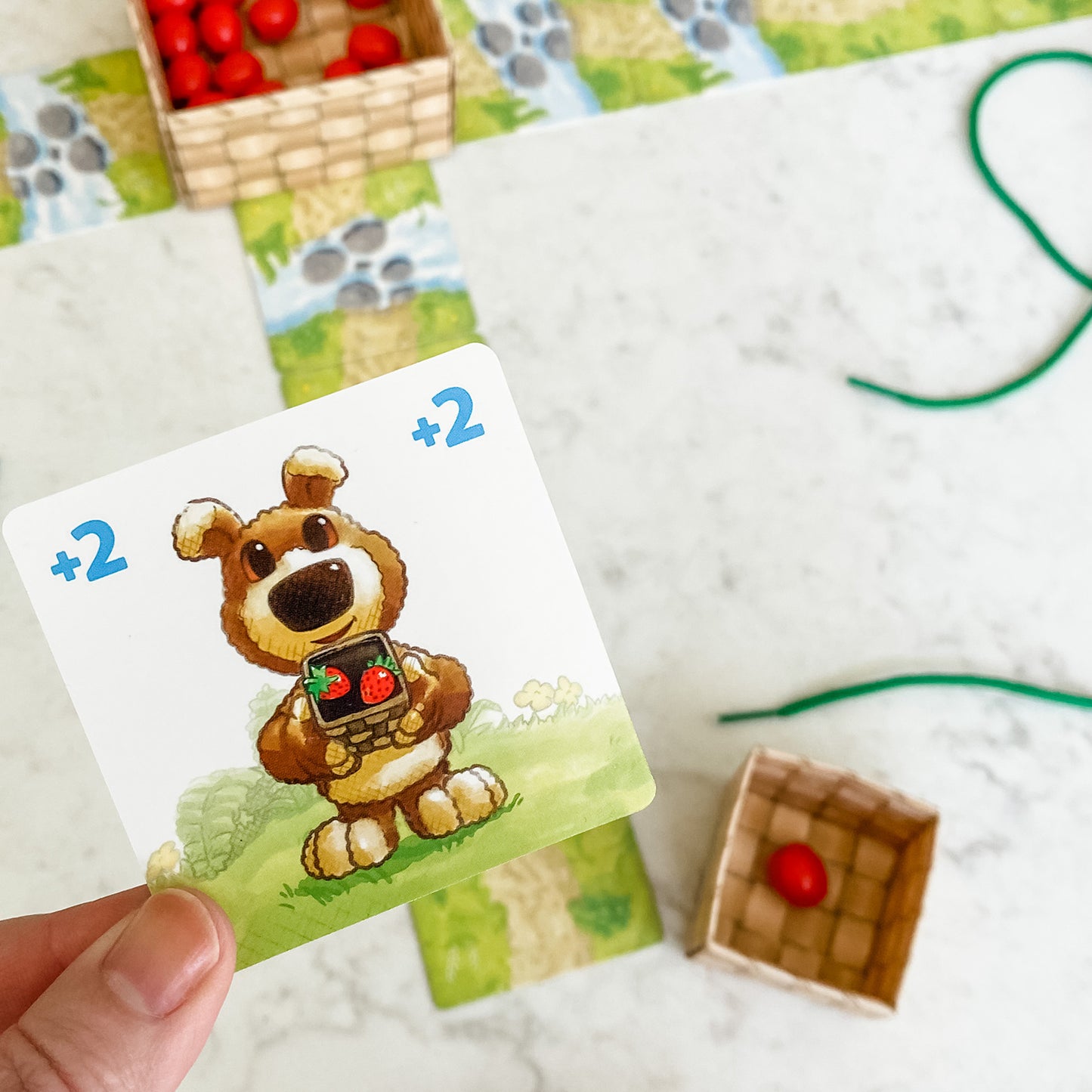
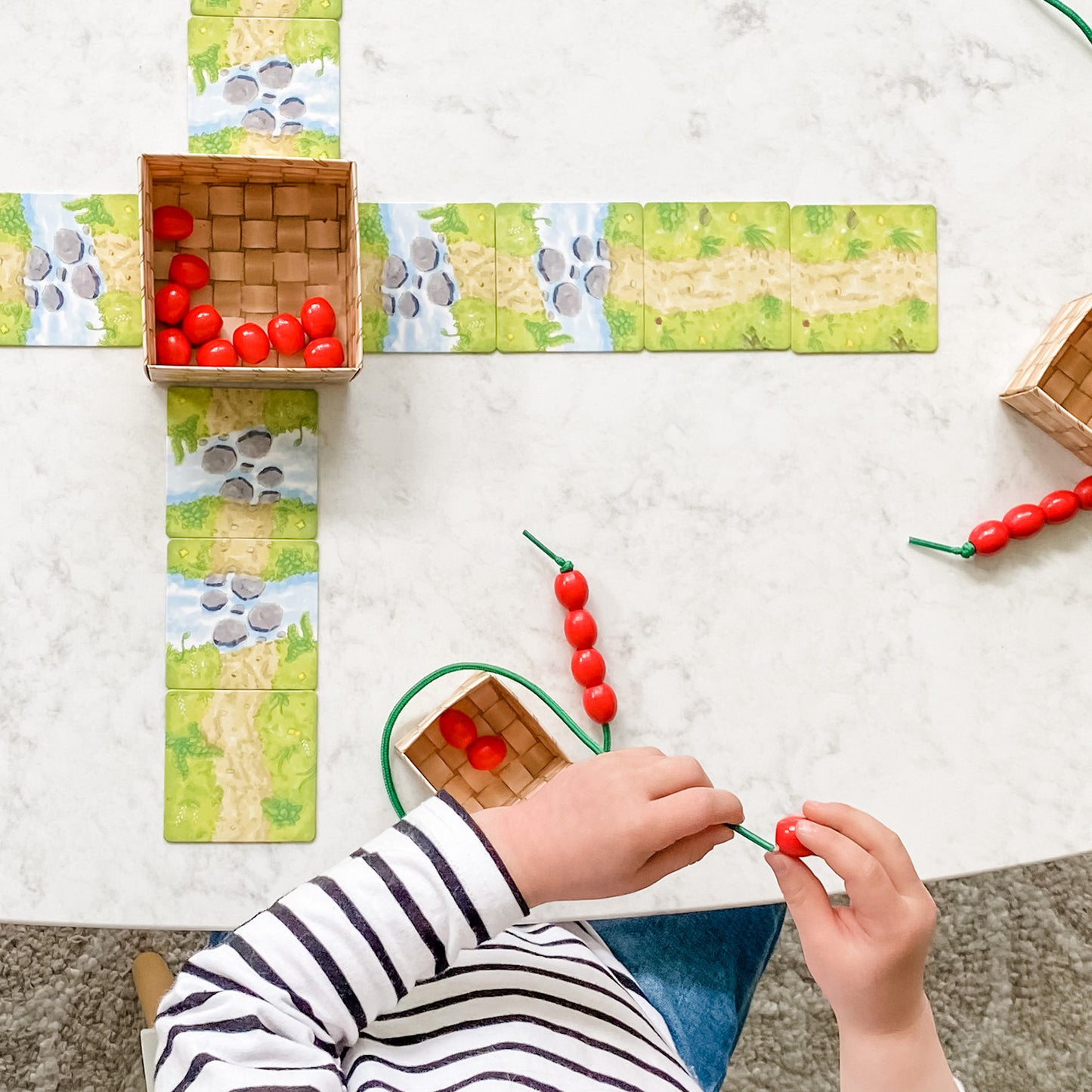
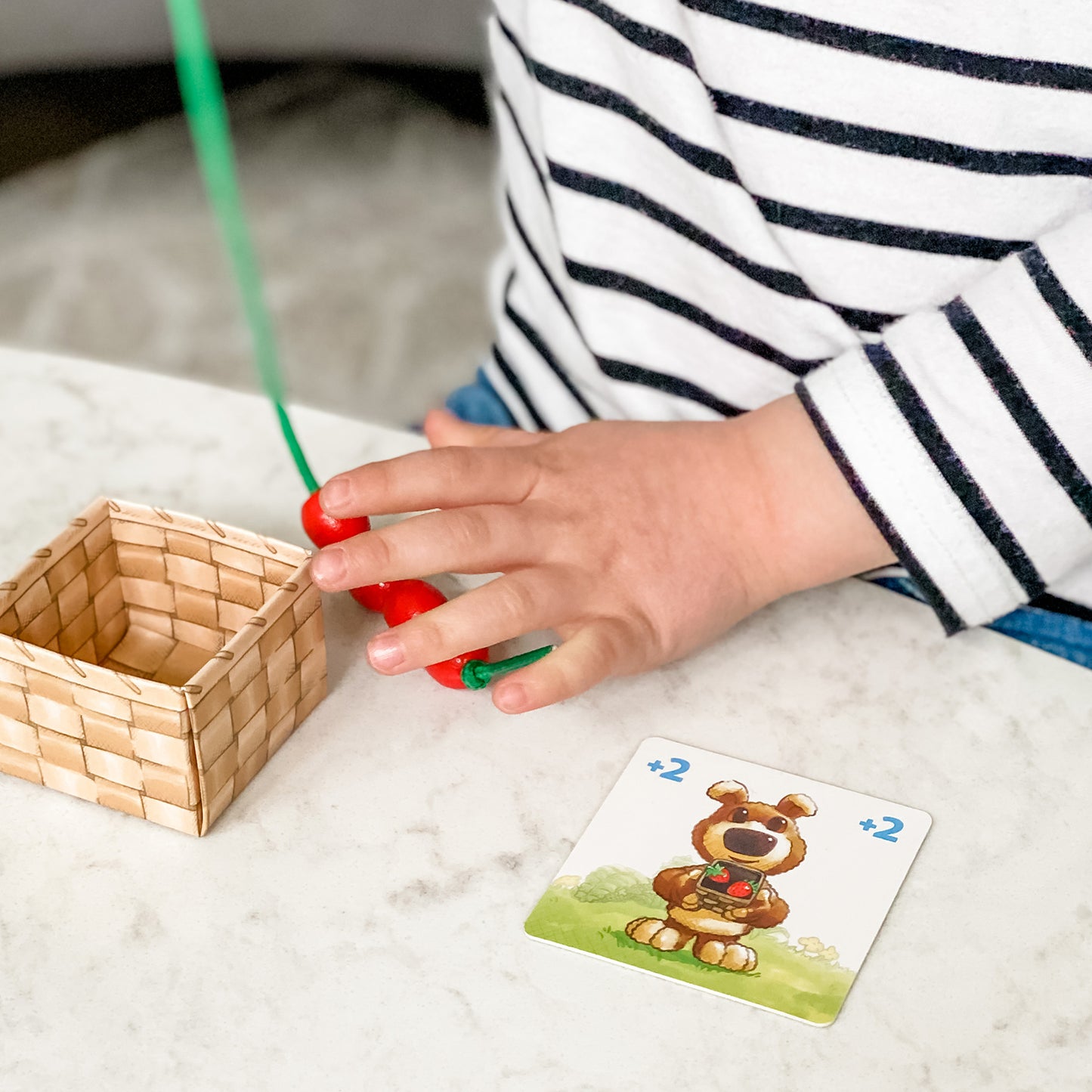


Collapsible content
How to Play
Educational Standards
Head Start*
Language
- Listening & Speaking
- Shows progress in understanding and following simple and multiple-step directions.
- For non-English-speaking children, progresses in listening to and understanding English.
- Develops increasing abilities to understand and use language to communicate information, experiences, ideas, feelings, opinions, needs, questions and for other varied purposes.
Math
- Numeracy & Operations
- Demonstrates increasing interest and awareness of numbers and counting as a means for solving problems and determining quantity.
- Develops increasing ability to count in sequence to 10 and beyond.
- Begins to make use of one-to-one correspondence in counting objects and matching groups of objects.
- Begins to use language to compare numbers of objects with terms such as more, less, greater than, fewer, equal to.
Core Standard*: Math
Math
- Counting and Cardinality
- Know number names and the count sequence. Grade Levels K
- Count to tell the number of objects. Grade Levels K
Skills
Determine
What Does Child Do To Use Skill In The Game?
Players determine the amount of beads to add or remove based on the tiles that are turned over. They also determine whether they need to pass beads to the left or right depending on the orientation of the bear on the River Path Tiles.
How Parents Can Assist Learning
Young children may not understand the math function (add or subtract), and therefore adults will need to explain and show the child what the "+" and "-" symbols mean. Encourage children to look closely at the River Path Tiles before making their move. This will help children, especially those with impulsivity, make the correct move.
On some turns, the child needs to give bead(s) to another player. If the child is reluctant, encourage them by praising how good they are is at sharing. Positive reinforcement will help with cooperation.
Learning Implications and Educator Support
Children will be applying simple addition, subtraction, and one to one correspondence in playing Share a Beary. Young children may not understand the math function (add or subtract), and therefore adults will need to explain and show the child what the "+" and "-" symbols mean. Encourage children to look closely at the River Path Tiles before making their move. This will help children, especially those with impulsivity, make the correct move.Share a Berry also involves social skills like cooperation and sharing. Educators can use positive reinforcement or role play to help children share more readily.
Compare
What Does Child Do To Use Skill In The Game?
Players need to compare the number on the tile with the beads in the Big Berry Basket or their Strawberry Strings. Players also compare the final amount of beads on their strings to determine the winner.
How Parents Can Assist Learning
Accurate comparison is required for children to successfully play the game. Encourage children to count out the number of beads each turn to help ensure accurate comparison. Children also compare length of beads on the string. This is important for teaching number units in relation to size units.
Learning Implications and Educator Support
Accurate comparison is required for children to successfully play the game. Encourage children to count out the number of beads each turn to help ensure accurate comparison. Children also compare length of beads on the string. This is important for teaching number units in relation to size units. Educators can also introduce concepts of units in length.
Practice
What Does Child Do To Use Skill In The Game?
Children will practice counting up to five with each card that is turned over.
How Parents Can Assist Learning
Parents can help children learn to count by asking them to count the total number of beads on their string after each turn.
Learning Implications and Educator Support
Players need to use one-to-one correspondence in each turn. This practice enables children to transition from rote counting to meaningful counting.
Solve
What Does Child Do To Use Skill In The Game?
Players solve the game by accurately adding or subtracting beads until the last turn is played.
How Parents Can Assist Learning
If children have difficulty counting the Berry beads accurately, hold or point to one bead at a time and while asking the child to say the next number. This will help the child learn to say one number with each object counted.
Learning Implications and Educator Support
If children have difficulty with one-to-one correspondence, educators can hold up one of the beads at a time as the child says the next number.
Review
What Does Child Do To Use Skill In The Game?
Players review their final Strawberry String of beads.
How Parents Can Assist Learning
No special parent support required. However, you can ask children to explain how the won or how someone else won the game. This will help you understand their thinking and comprehension of the game rules.
Learning Implications and Educator Support
No special educator support required. However, you can ask children to explain how the won or how someone else won the game. This will help you understand their thinking and comprehension of the game rules.
Demonstrate
What Does Child Do To Use Skill In The Game?
At the end of the game the winner explains by counting or showing the length of his or her beads.
How Parents Can Assist Learning
If children have difficultly counting the total number of beads, remind them that they can lay their Strawberry Stings next to each other. The one of the longest line of beads wins!
Learning Implications and Educator Support
Justification is an important part of learning as it an element of logical reasoning that reflects the child's underlying comprehension of the rules as well as what they did to win the game. When children show their understanding, educators can hear how they think.
If children have difficultly counting the total number of beads, remind them that they can lay their Strawberry Stings next to each other. The one of the longest line of beads wins!
*Data compiled from CCSSI ELA Standards, WA Science Standards, and Washington Social Studies Standards
Special Needs
Cognitive
Suggestions for How to Modify Play Experience
This game is good for young children of all cognitive levels so long as they can count up to 5.
To build additional math ability, encourage children to "count on" when they add more beads. Counting on is the ability to add numbers to the prior last number reached. For example, assume there are 3 beads on the child's Strawberry String. If s/he selects a +2 tile, s/he would count the 3 beads on the String and then say "four" when adding the next bead and "five" when adding the last bead.
Communication
Suggestions for How to Modify Play Experience
Adults or other players can turn over a tile and say the number and math function (ex: plus two). The child then draws or removes that number of beads. This demonstrates the child's receptive language comprehension for numbers.
Encourage children to say aloud the number and math function, as well as to count each bead as it is added or removed from the Strawberry String.
Sensorimotor
Suggestions for How to Modify Play Experience
This game allows children to practice fine motor development through threading. If threading is too challenging, children can collect the berries in their baskets.
If a child has difficultly turning over the tiles, another play can assist.
Social Emotional/Behavioral
Suggestions for How to Modify Play Experience
For 3 or 4 players, try a cooperative variation of Share a Berry where the goal is for all players to end up with the same number of berries at the end. The game is set up and played the same, except when a player turns over a River Path Tile, they may give berries to the person on the left or right. Also, they may divide up the number of berries to give. For example, if a player turns over the -3 River Path Tile facing left, they may give 1 berry to person on left and 2 to person on right, or they may give all 3 to person on right, and so on. This will help children develop empathy and thoughtfulness for other players because all players are trying to achieve the same goal. It also adds an element of planning and problem-solving that can help develop strategic thinking and collaborative problem-solving skills.
If children become agitated by having to remove beads, try initially playing the game using only the Berry Path Tiles. After the children become accustomed to winning and losing with the Berry Path Tiles, add the River Path Tiles to the game play.
Vision
Suggestions for How to Modify Play Experience
Children with low vision may not be able to read the numbers on the tiles. Use a black maker to rewrite the number values (ex: -1 or +3) larger and darker.
Hearing
Suggestions for How to Modify Play Experience
This game does not require modification for children with hearing impairment.
*Data compiled from CCSSI ELA Standards, WA Science Standards, and Washington Social Studies Standards
Autism
Autism Strengths & Interests
Short Summary of Strengths & Interests
- Prefers cooperative play.
- Likes to use their dexterity with small objects in play, especially threading type of activities.
- Likes counting.
Is good at matching visual items
Is This Game Appropriate? Yes
Description
Share a Berry requires children to turn over and look at the picture on their path. They then match the number on the card to the real objects, or "berries" they put on their string.
Has a good memory for sensory details, including visual, touch, taste and smell
Is This Game Appropriate? Yes
Description
The action of threading the bead requires the child understands how to orient the bead and string in order to combine them. Children feel a sense of accomplishment with each bead added.
Has a good memory for words, phrases and dialouge
This game is not appropriate
Has a good memory for pictures, numbers and patterns
This game is not appropriate
Likes to put things in order or a sequence
Is This Game Appropriate? Yes
Description
Threading the beads at each turn leads to a longer and longer string of beads. There is no right order of beads, only the right number, so children are reinforced for saying the right number by getting to add that number of beads to their string.
Learns through visualizing or "replaying" actions in their mind
This game is not appropriate
Likes activities with rules, such as math and phonics
This game is not appropriate
Is very concrete and literal
Is This Game Appropriate? Yes
Description
The game is very concrete, with pictures and objects (berries) as the key components of the game. The berries are a concrete representation of the numbers, thus, building number concepts in a concrete way. The winner is also determined by a visual comparison of amounts of beads strung.
Learns in small "chunks" (for example, phone numbers are 3 chunks of number xxx-xxx-xxxx that are combined together)
This game is not appropriate
Is good at nonverbal reasoning and logic
This game is not appropriate
Likes spatial problem solving
Is This Game Appropriate? Yes
Description
Simple spatial problem solving is involved at the end of the game when players compare the length of their strings of beads to see whose has longest.
Can read well with good vocabulary, though may not fully comprehend content
This game is not appropriate
Likes to use and has good fine motor skill
Is This Game Appropriate? Yes
Description
Children who like lining things up and stringing beads will enjoy putting the "berries" on the string during their turn. This will be a motivating factor to play the game!
Likes established routines or set ways of doing things
Is This Game Appropriate? Yes
Description
One advantage of Share a Berry is that the entire game is set out at the start. No card drawing or movement of pieces needs to be tracked. The same routine is followed on each turn. The simplicity and routine of play is an advantage for children who like sameness.
Likes manipulating, constructing or building things
Is This Game Appropriate? Yes
Description
Manipulating and making a long string of beads is motivating to children who like manipulating small objects and putting them in a sequence.
Likes to use and has good musical abilities
This game is not appropriate
Likes to use and has good drawing skills
This game is not appropriate
Autism Special Considerations
Appears to ignore other's communication and/or has difficulty giving eye contact to a communication partner
Is This Game Appropriate for Child with Characteristic? Yes
Can Child with Characteristic Play Game w/o Modification? Yes
Strategies for Developing Compensatory Skills:
Sit at an angle to the child, so direct eye contact is not needed.
Look at the game instead of each other.
Communication is not required in Share a Beary, but should be encouraged.
Has difficulty understanding complex verbal directions
Is This Game Appropriate for Child with Characteristic? Yes
Can Child with Characteristic Play Game w/o Modification? No
Strategies for Developing Compensatory Skills:
Break down directions into small steps. Don't go through all the directions at once.
Combine short verbal instructions with visual and physical examples of each step.
Use the online video at Simplyfun.com to walk children through the directions. Video support is helpful for children with special needs.
Use hand-over hand guidance if needed, so children feel the actions as the directions are being given. This helps develop the child's memory for the correct movements.
Gradually reduce the support as the game is learned.
Check for comprehension by asking the child to show you what to do next.
Make sure children understand the meaning of the pictures on the cards in relation to the numbers on the cards.
Uses vocabulary inaccurately or demonstrates echolalia (repeating another's speech)
Is This Game Appropriate for Child with Characteristic? Yes
Can Child with Characteristic Play Game w/o Modification? Yes
Strategies for Developing Compensatory Skills:
Respond to immediate echolalia (repeating what was just said) by rephrasing the child's response into a correct format, so the child can hear and repeat that phrase. For example, assume you are playing with a child named Andy and you say, "Your turn," and Andy repeats, "Your turn." You can say, "It's Andy's turn. You say, my turn." This allows the child to hear and repeat the correct response. Eventually, the child will pick up the pattern of response.
Delayed echolalia (repetition of previously heard comments) may have a hidden meaning or association. Look for connection in the phrase used to the current situation. For example, the child says, "After these messages we'll be right back!" Think what the repeated phrase is associated with for the child. Try to interpret what is meant and rephrase it for the child. For example, you might respond by saying, "It sounds like you want a break for a few minutes. Is that what you mean? You can tell me, 'I need a break.'"
Gets stuck repeating a verbal topic or physical actions and/or has difficulty attending to others' actions or topic.
Is This Game Appropriate for Child with Characteristic? Yes
Can Child with Characteristic Play Game w/o Modification? Yes
Strategies for Developing Compensatory Skills:
Remind children about listening and watching others' before making their own comment or action.
Use a motivation toy or object to gain the child's attention. For example, a preferred wind-up toy can be placed on the board when it is the child's turn. The child gets to wind up the toy after completing their turn.
Extend the child's action to make a correct response. For example, if the child turns over a card, ask, "Now what should you do?"
Reinforce attention and actions by commenting on what was done correctly. For example, "You remembered to put two berries on your string!"
Has difficulty producing speech/communication
Is This Game Appropriate for Child with Characteristic? Yes
Can Child with Characteristic Play Game w/o Modification? Yes
Strategies for Developing Compensatory Skills:
Conversation is not required, but players can be encouraged to comment on each others' plays.
Talking is not required, but ask players to say out loud what the card means and comment on their actions. This gives the child practice in initiating a conversation. The adult should respond with a conversational turn. For example, the child says, "Two." The adult can say, "Yes, you can pick two berries." This gives the child an example of the meaning of the problem and also offers a response to their statement.
Provide at least 10 seconds wait time for the child to process or produce responses. It may take longer to formulate a thought or response for children with special needs.
Has difficulty sequencing multi-step actions and/or doing complex abstract tasks
Is This Game Appropriate for Child with Characteristic? Yes
Can Child with Characteristic Play Game w/o Modification? No
Strategies for Developing Compensatory Skills:
Children with special needs may need prompting for each different part of the game sequence (adding beads, sharing beads, etc, etc.)
Although the directions are fairly simple, children may not understand the meaning of the representations on the pictures without support. Children may need prompts related to adding and subtracting berries.
Children with special needs may need prompting for each different part of the game sequence (adding, taking away, counting, comparing).
Demonstrates difficulty initiating and maintaining social interactions
Is This Game Appropriate for Child with Characteristic? Yes
Can Child with Characteristic Play Game w/o Modification? Yes
Strategies for Developing Compensatory Skills:
Develop a social story to be read at the start of a game. A social story is a short booklet that illustrates how a child can use positive social skills. It includes two to five descriptive statements and a directive statement. For example: "When I watch others, I will know when it is my turn. Others like me when I take turns. I will watch what others do with their pieces and listen to what they say. Others like it when I talk about the game." Add photos or drawings of the child doing the actions described in the story.
Add a social component to the game by having children make up a story about picking berries.
Acts out or demonstrates avoidance behaviors when frustrated, overwhelmed, or needs more sensory input.
Is This Game Appropriate for Child with Characteristic? Yes
Can Child with Characteristic Play Game w/o Modification? No
Strategies for Developing Compensatory Skills:
Reduce extraneous noise or allow the child to wear head phones or ear plugs if loud sounds cause anxiety.
A weighted vest worn during the game may provide additional pressure input and thus reduce fidgeting due to sensory needs. Pressure can be calming when used for no more than 20 minutes at a time.
Practice a phrase to ask for help and role play situations in the game where it is needed.
Provide techniques for self-calming, such as holding a special toy.
Allow time for movement. For example, a child who needs to move frequently can be given an opportunity to 'celebrate' their turn by running around the table or jumping up and down 10 times.
Has short attention span for non-preferred activities
Is This Game Appropriate for Child with Characteristic? Yes
Can Child with Characteristic Play Game w/o Modification? No
Strategies for Developing Compensatory Skills:
Provide a break when needed.
Use "when...then" phrases. For example, "When you take your turn, then I'll let you play with your toy."
Frequently remind the child of the goal of the game.
Incorporate a motivating activity as part of the play. For example, each player gets to manipulate a fun 'fidget' toy, such as a stress ball or squeeze toy in between turns.
Needs sameness or consistent routines and/or has difficulty with transitions from one activity to another
Is This Game Appropriate for Child with Characteristic? Yes
Can Child with Characteristic Play Game w/o Modification? No
Strategies for Developing Compensatory Skills:
lay games at the same time every day, so the child anticipates the game routine.
Change the location of the game, so the child may play in different rooms, at the table, or on the floor. This will build tolerance for variation. Prepare the child ahead time for the introduction of a new game. Talk about aspects that will be motivating for the child, and let them explore the parts of the game before setting out the whole game.
Provide a structure for placement of game pieces that can be the same each time the game is played. For example, have a specific location for where the board goes, the pieces, etc. Provide choices for how the child can be involved in set up or clean up. For example, you might ask, " Do you want to set up board or hand out the strings?" Involve the child verbally and with actions for the transition to the game table or at the end of game play. For example, you might say, "Let's look at the pictures on the game box and guess what it is about."
Use an object cue. Let the child hold an object from the game or activity you want to introduce prior to the transition. For example, if you were intending to play Share a Beary you would hand the child a berry and say, "Look here is a berry. Let's see where it goes."
Has difficulty understanding others' feelings, intentions, and the reasons for others' actions.
Is This Game Appropriate for Child with Characteristic? Yes
Can Child with Characteristic Play Game w/o Modification? Yes
Strategies for Developing Compensatory Skills:
Children do not have to understand other players' feelings or intentions, but they should be encouraged to pay attention to others.
Model and point out what others are feeling and comment on their facial expressions or words.
Discuss what causes feelings in others. For example, "You are happy because you picked two berries. But, look at Joe's he is also happy. He is sharing a berry." Ask the child to explain their own feelings and intentions.
*Data compiled from CCSSI ELA Standards, WA Science Standards, and Washington Social Studies Standards
Extended Play
Extra Ways to Play the Game
Try to Tie Version: This variation is for 3 or 4 players. The goal is for all players to end up with the same number of berries at the end. The game is set up and played the same, except that when a player turns over a River Path Tile, they may give berries to the person on the left or right. Also, they may divide up the number of berries to give. For example, if a player turn over the -3 River Path Tile facing left, s/he may give 1 berry to person on left and 2 to person on right, or they may give all 3 to person on right, and so on.
Materials Needed
No additional materials needed..
Developmental Benefits
This variation is cooperative by design. This will help children develop empathy and thoughtfulness for other players because all players are trying to achieve the same goal. It also adds an element of planning and problem-solving that can help develop strategic thinking and collaborative problem-solving skills.
Extra Ways to Play the Game
Spoon race with berries: Use a teaspoon, place a berry in it, and let children race in a safe space. If the berry falls out, they start over. This can be a relay or group race to a finish line.
Materials Needed
Teaspoons and the berries.
Developmental Benefits
Walking or running while carrying a berry in a teaspoon develops balance. The child also needs to think about two things at the same time, namely, running/walking (a gross motor task) and carrying (a fine motor task). This complicated task builds coordination and concentration.
Extra Ways to Play the Game
Bead stringing patterns: If you have beads of similar size but different colors, create a list of different patterns to make and give them to the children one at a time. For example, ask the children to take 5 red beads and 5 blue beads. Then, ask them to make a repeating pattern of one color (ex: one red, one blue, one red, and so on). Then, do that again with repeating pattern of 2 colors. Then ask the children to make up their own patterns and show them off. If you like one, perhaps it can become a bracelet for someone!
Materials Needed
Additional beads that are different colors and roughly the same size.
Developmental Benefits
Threading helps young children develop hand-eye coordination and fine motor skills. These threading skills can be combined with others to ultimately develop a wide range of complex physical skills such as tying a shoe, using a fork, hitting a baseball and writing. Recognizing, matching and creating new patterns are foundational for later skills development in geometry, science and art.
Extra Ways to Play the Game
Use various cereals with holes in the middle instead of the beads in the game. When playing the River Path cards, the player giving the cereal pieces gets to tell the player if they should string them or EAT them! The goal in this variation is for all players to end up with the same number of cereal pieces.
Materials Needed
Cereal with a hole in the middle.
Developmental Benefits
This variation allows children to study what the other players have on their string already. The decision to tell a player to place or eat the cereal involves some strategy as children try to help others align their number of cereal pieces with everyone else's.
*Data compiled from CCSSI ELA Standards, WA Science Standards, and Washington Social Studies Standards
Collapsible content
How to Play Video & Transcript
A game where players collect berries while having fun sharing and counting.
You can play Share a Berry with 2-4 players, ages 3 and up!
Share a Berry is good for developing Fine Motor Skills as players count out beads and thread them onto their strings.
Share a Berry also helps players learn to Taking Turns as they wait patiently for others to complete their turns.
Shuffle all Berry Path Tiles and all River Path tiles separately.
• Place the big Berry Basket in the middle of the table. Then place all 28 strawberries (red beads) into the Basket.
• On each side of the Berry Basket, place 6 Path Tiles – 2 River Path Tiles and 4 Berry Path Tiles.
If playing with two or three players, only use two or three sides of the basket. The River Path Tiles can be distinguished by the blue water on the back of the tiles and should be placed closest to the big Berry Basket. Each path extending out from the Basket belongs to one player.
• Pass one mini Berry Basket to each player.
• Hand each player a Strawberry String. Each string should have a knot at one end. During game play, players will thread strawberries onto their string.
• The youngest player starts the game, and gameplay proceeds clockwise around the table.
First collect, and then share berries based on the numbers revealed on your Path Tiles. When all the tiles have been turned over, the player with the most berries wins!
When all of the tiles have been turned over and all the sharing is done, the game ends. Now each player should count up their strawberries. The player with the most strawberries wins! In case of a tie, those players share the victory.
Have fun picking berries, counting and learning the joys of giving and receiving while playing Share a Berry!
- Choosing a selection results in a full page refresh.
- Opens in a new window.

